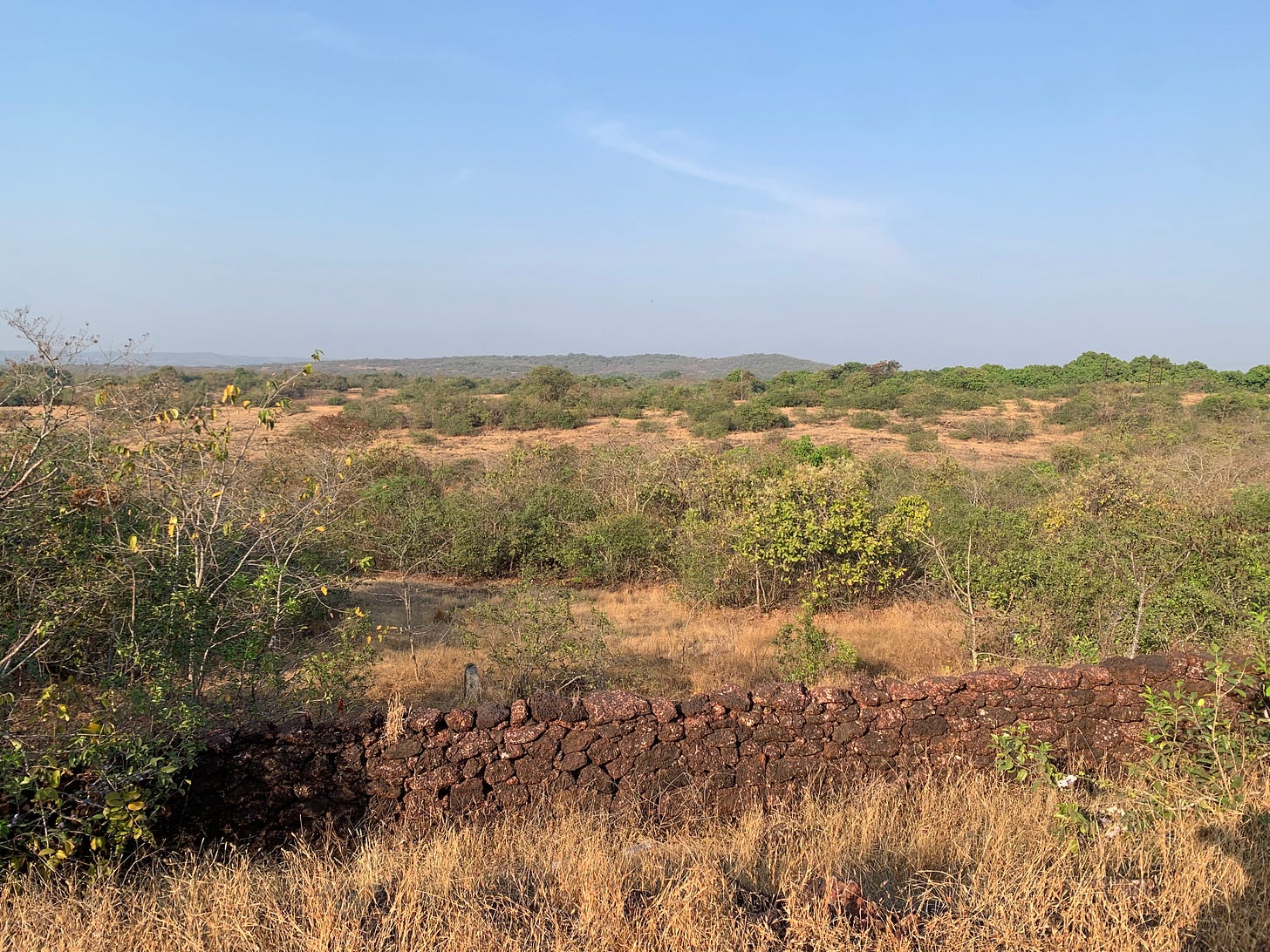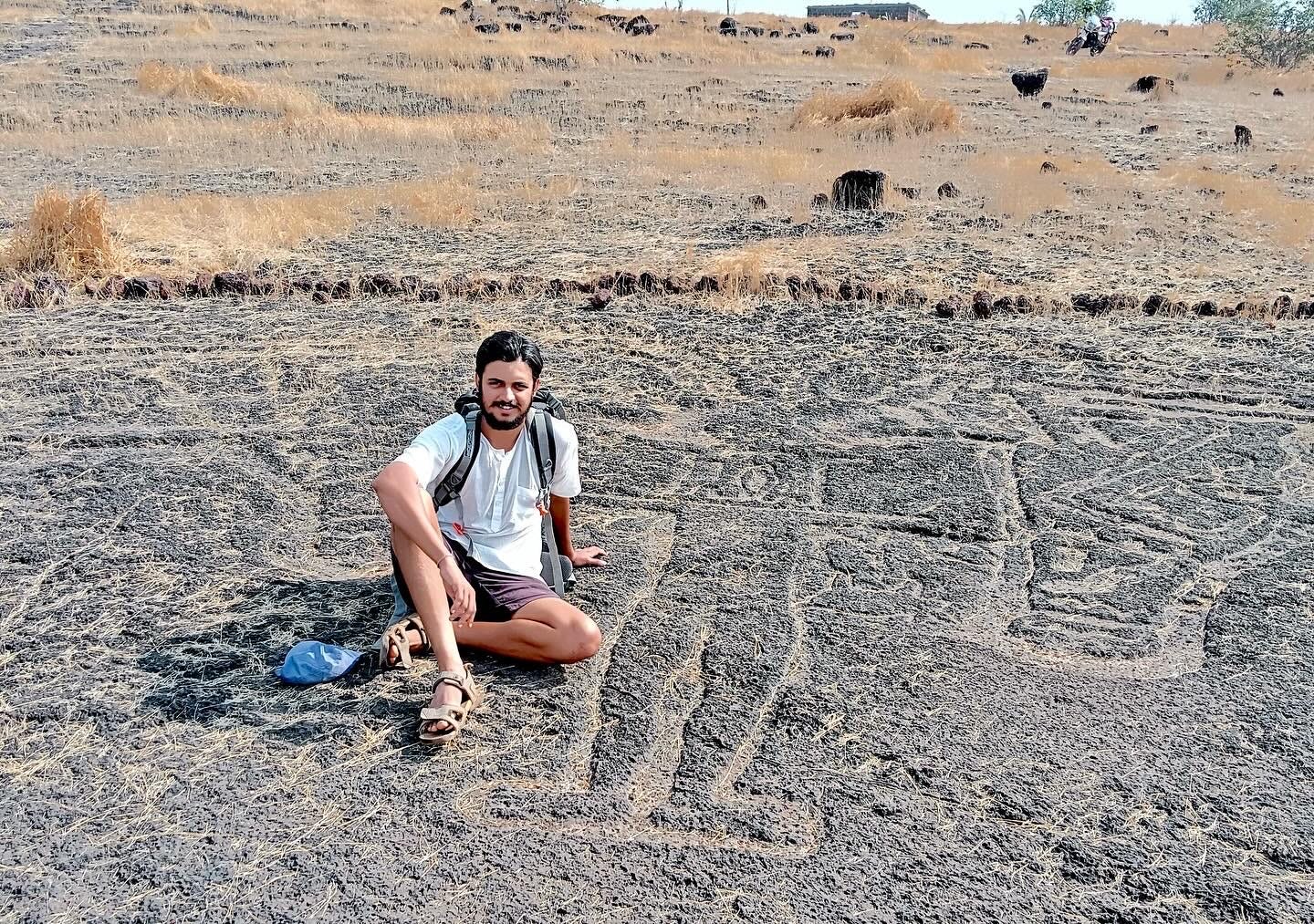There is more to Rajapur than simply a few cities and beaches. Rajapur, given the recent discoveries, seems to be the epicentre of a long lost civilisation— or atleast the ancestors of some of the people living here. The flat laterite that spans all around the Rajapur belt, hides in its bosom hundreds of petroglyphs/geoglyphs. These are not just carvings on stone, they are indicators that man, thousands of years past, was looking around, observing and also noting his surroundings. When he was still a hunter gatherer, he saw huge mammals, animals, fishes which he then carved on the porous laterite. They show us that Konkan was not simply some random space which was populated by tribes. Konkan has a deeper and richer history. How can it not be? Afterall Konkan (Western Ghats) is older than the Himalayas! It is said to be 150 million years in making whereas Himalayas are only 50 million in making..
When I met Sanjay Molur and Suhas Gurjar near the Gaokhadi beach, Sanjay instantly invited me to their base, the Devi Hasol Bhakt Niwas. He has been working in the conservation sector with Zoo Outreach Organisation, Coimbatore. The 4th batch of the Ram Hattikudur Advanced Training in Conservation were out here in the field on a mentorship program working on the threatened ecosystems of rock outcrops on the Konkan sadas in Maharashtra and the fellows were multitasking to ensure the issue reflects their work over the last 3 months in the course. I was startled to know that 15 fellows from all over India (none of them from Maharashtra) were more concerned about the damage done to the sadas, when our own people and ministers saw nothing but flat surfaces. After spending an evening with them, sharing and discussing ideas that have come up during my walk, I was sure that I was not the only person seeing the sada differently.
The sada or kaatal (laterite plateaus) although barren in this season, blooms with beauty during the monsoon. Their view, that these sadas have a uniquely distributed flora and fauna— that in many places is native only to this land, was also shared by the recent UNEP Champions of Earth, Madhav Gadgil. It saddens me that when we are praising Gadgil for getting this prestigious award, his report was not accepted and implemented by the government. His report basically brings the entire Konkan and Sahyadri region under the eco-sensitive category. That’s how important Konkan is!! Meaning that if this report is to be accepted by the government, they would have to stop all the mining, monoculture and malpractices that are destroying this region. While we laud a great environmentalist for his efforts on publishing such a splendid report, we care not an ounce that his ideas are not even welcome. It doesn’t mean that Konkan shouldn’t progress. It gives ample of space for progress, but like some great saint has said previously, nature has enough for man’s needs but not for his greed.
While traveling to Devi Hasol with Suhas Gurjar, I came across a fascinating landscape, that even to me, a native Konkani who has traveled around Konkan many times, was foreign. The flat lands with gradual slopes made out of laterite were untouched by any human habitation. You could see as far as your eyes could reach and yet you would not see a single human intervention in sight. These flat grasslands are rich in wildlife and are probably the last remaining grazing and hunting fields for our wilderness. Leopards, Gaur, foxes are amongst a few of the commonly seen animals, but do we know how many species occur in the Western Ghats? Despite covering less than 6% of India’s land area, they harbour an astonishing 30% of the country’s plant, fish, amphibian, bird, and mammal species. This includes a significant number of endemic species found nowhere else on the earth, underscoring the global importance of this ecological treasure.
Why Western Ghats need protection?
Nearly 4,000 species of flowering plants or about 27% of the country’s total species are known from the Ghats.
Of 645 species of evergreen trees, about 56% is endemic to the Ghats.
Among the invertebrate groups, about 350 (20% endemic) species of ants, 330 (11% endemic) species of butterflies, 174 (40% endemic) species of odonates (dragonflies and damselflies), and 269 (76% endemic) species of mollusks (land snails) have been described from this region
The known fish fauna of the Ghats is 288 species with 41% of these being endemic to the region. The Western Ghats are particularly notable for its amphibian fauna with about 220 species, of which 78% are endemic.
Similarly, the Ghats are unique in its caecilian diversity harbouring 16 of the country’s 20 known species, with all 16 species being endemic.
Of the 225 described species of reptiles, 62% are endemic.
That’s where we are sitting. Konkan comes to life not during the winter or summer, but during the monsoon.
If you would like to support me, please consider buying me a coffee. I am working on this project full-time, thus your support means that I have a means of continuing this work.
Gadgil Committee report specifies that the present system of governance of the environment should be changed. It asked for a bottom to top approach (right from Gram sabhas) rather than a top to bottom approach. It also asked for decentralization and more powers to local authorities.
Now I understand why this report was disregarded. The basic issue of need vs. greed. Our hunger for more and the corporates who had already invested heavily in land, would have had to leave out on a lot of money. So lets package you progress “vikaas” with a different label, but only the kind that will make us money.
Many moons past, man would be running from these flat lands, given the threat caused by such wild beasts, but now he has grown smart. He wants revenge and thus he is now looking out to conquer this last remaining wilderness. It was no wonder when Karandikar kaka, the caretaker of Devi Hasol bhakt niwas, mentioned that most of this land is now private. I beg to ask this question, how can this land, which has not a human influence in sight, be owned by anyone other than mother nature? Why can’t we declare these as conserved areas? Let’s just keep some of them as they are; raw and untouched. Not the entire coastline but some pockets of wilderness where our future generations can see the beginnings of our world. The raw nature— as it is. America too had to work out a way in which they would conserve such areas. When the winds of industrialization extracted a lot of resources, there were people like John Muir, who advocated for the value of country’s wilderness. It was his efforts that inspired a generation of adventure and wilderness advocates. If they could do it in then, in the year 1892, why can’t we do it now?
"Keep close to Nature’s heart… and break clear away, once in a while, and climb a mountain or spend a week in the woods. Wash your spirit clean." — Son of the Wilderness, John Muir
"One touch of nature makes the whole world kin."
-John Muir
Thank you for the help provided so far and for being a part of this walk! I now have a team assisting me and if financial support can be provided to keep them going, then please do so. here’s the link
For Indians who want to support'/contribute, here is the UPI payment number GPay or PhonePe- 8983726737
The idea of this walk is to highlight the issues, spread an ecological conscience within the people, listen to them and bring them together to see if we can bring about a change that can move towards a future that aids people rather than pushes them away from their homeland.
If you can help me by contributing for this walk, then please do, I could start a kickstarter or manage crowdfunding through some other website, but none of those options are available to me here in India. So, I will be dependant on your donations. You can contribute through paypal - here’s the link. I will send out a personalised postcard if the donations are above $30 and if it’s above $100 then whatever comes out of this walk - a book, a documentary or anything else - you will be the first ones to receive it.








